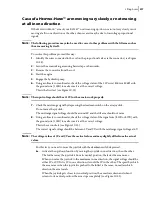
396
Lifting Arms
When the converted signal reaches the proportional coil, it has a voltage of between 3V and 9V (6V
being called the neutral signal or mid-range signal). An input signal having a range of 6V-3V moves
the in/out section spool to one side and an input signal having a range of 6V-9V moves the in/out
section spool to the other side. The same goes for the up/down section of the proportional valve.
N
OTE
:
Only the in/out and up/down sections of the arm valve have proportional coils which allows
the section spool to move to one side or the other depending on the input signal coming from
the PWM adapter.
Attached to the proportional coil is a connector to which three wires are connected: the ground wire,
the 12V wire and the signal wire.
The incoming signal traveling to the proportional coil via the signal wire causes the section spool to
move to one direction or the other. The speed by which the spool moves, and incidentally the arm,
depends on how far the joystick goes from its neutral position. The further away the joystick goes
from the neutral position, the faster the arm moves, either up and down or in and out.
As a benchmark, an input signal of 3V or 9V traveling along the signal wire and entering the
proportional coil will cause the section spool to move very swiftly in either direction (3V signal in one
direction, 9V signal in the other direction with similar speed). If the voltage value of the input signal
gets closer to the neutral signal value (that is 6V), the speed by which the spool moves will decrease.
For example, a signal with a voltage of 7.5 or 4.5 will induce a speed loss, meaning the arm will move
slower, either during in/out or up/down cycles.
Figure 10
-
22 Signal voltage
N
OTE
:
As far as the proportional input signal is concerned, a voltage of 3V is by no means slower than
5V. It is rather the following principle that must be taken into account: the further the voltage
value is from the mid-range value (that is 6V), the higher the speed increases.
The proportional coil, receiving the electric signal from the joystick via the PWM adapter, provides a
finer gradation of speed of the H
ELPING
-H
AND
™ arm in both in/out and up/down cycles. The
position of the joystick determines the speed by which the arm moves. The coil reacts to the position
of the joystick with the right level of voltage for pushing the spool accordingly. The achieved speed or
the strength of the signal current must match the exact position of the joystick.
6V
Slower
3V
9V
Slower
8.5V 8V 7.5V 7V 6.5V
5.5V 5V 4.5V 4V 3.5V
Fast
Fast
Neutral
Summary of Contents for EXPERT
Page 1: ...EXPERT TM MAINTENANCE MANUAL...
Page 2: ......
Page 3: ...EXPERT MAINTENANCE MANUAL...
Page 10: ...viii Table of Contents...
Page 18: ...8 Introduction...
Page 244: ...234 General Maintenance...
Page 251: ...Lubrication 241 Figure 4 11 Glass compartment lubrication chart optional...
Page 252: ...242 Lubrication Figure 4 12 EXPERT lubrication chart...
Page 264: ...254 Lubrication...
Page 320: ...310 Hydraulic System...
Page 357: ...Troubleshooting 349...
Page 358: ...350 Troubleshooting...
Page 386: ...378 Multiplexing...











































